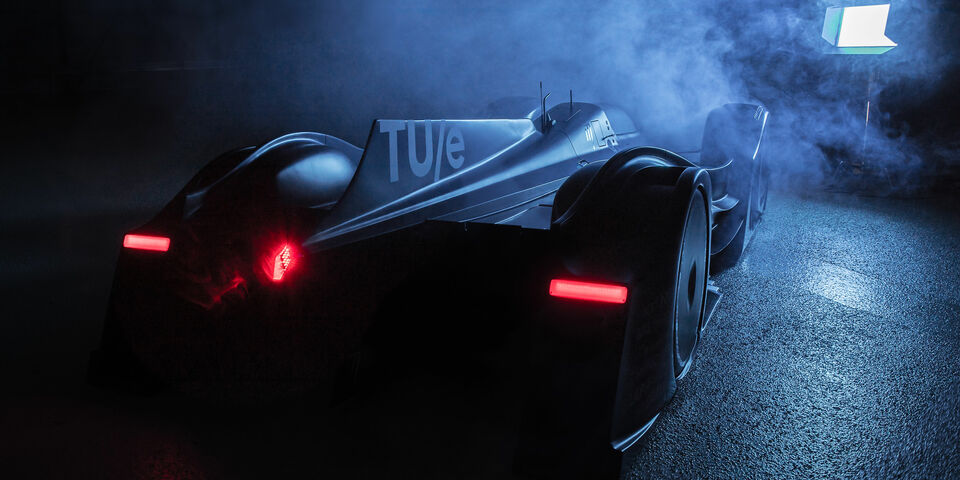InMotion wants to tackle charging time with new racing car
Student team InMotion last night revealed its ‘Vision’. In the coming years the TU/e-cum-Fontys student team intends to use this concept racing car especially to show that the charging of electric vehicles can be considerably faster - eventually as quickly as filling your petrol tank.
Zandvoort, Zolder, Assen. With its IM/e car InMotion has in the past two years generously broken the speed records for electric vehicles on these tracks. Beautifully mediagenic milestones these were for the six-year-old student team, though the underlying message and objectives of InMotion for the longer term were not borne out all that clearly to outsiders, says marketing manager Gijs Herings. An extra challenge in propagating the mission is probably also the lack of a competition that gives something to hold on to - such as the Formula Student for University Racing Eindhoven and the World Solar Challenge for Solar Team Eindhoven.
In consultation with his partners and the Supervisory Board the team worked hard last year, as Herings emphasizes, to create a more distinct image (including a new corporate style), which should make the end goal of InMotion more easily understandable for outsiders as well. For InMotion’s record-breaking racing car IM/e - meanwhile renamed Fusion - is a “very cool concept, though in the end it is merely a part of the long-term vision”, formulates Herings’ co-spokesman Cas Verstappen.
Last hurdle
In order to present a clearer picture of the future, InMotion last Tuesday night revealed its 'Vision', in which Verstappen says that all the lessons learned from the preceding two cars have come together, which the team can now elaborate on. With this concept car (a mock-up at this stage) the team, as it explains, wants to clear the last hurdle to electric mobility. After all, the basis is there, the whole battery business is booming anyway and a lot of progress has already been made, says Herings - but developments must and can be realized faster.
Read on below the photo.
There is a still a lot to be gained for electric vehicles when it comes to rapid charging, as InMotion sees this. And that is precisely the crux of the team’s current mission: a drastic reduction in the charging time of electric vehicles. No full hour of charging batteries so as to be able subsequently to cover another four hundred kilometers, but plug in for two minutes - and GO. “We hope that we shall within eighteen months to two years have a car with which that can be realized.”
Heat
According to Herings this is perfectly possible. “The greatest difficulty is the amount of power that needs to be fed to the car within a short time span and the heat that is released during the charging process. You also notice this when charging your mobile phone: this proceeds ever faster, but your phone does tend to become a lot hotter. The same thing applies when charging a car. To do so safely, you need to install a proper cooling system.”
Of course, a racing car like the one being developed by InMotion is not a car for consumers yet, as Verstappen is well aware. “Still, you see that there are many developments in racing, for example in Formula 1, which are soon transferred to ordinary passenger cars.” The ‘Garage 56’ of the 24 Hours of Le Mans is an example in kind, Herings adds. For that famous annual race in France, more specifically the said experimental category, is still high on InMotion’s agenda.
Approved chassis
2023 is the year in which the student team hopes to appear at the start on the French track with its Vision. Unlike its predecessors, this new racing car will not, for that matter, be built by the students themselves from the bottom up. Verstappen: “To qualify for taking part in Le Mans, you need to have an approved, i.e. an existing chassis. At present we are looking at a number of manufacturers to see which chassis would fit into our picture best and what would be the best option for us to incorporate our fast-charge technology.”
In Herings’ opinion, the greatest challenge is in embedding the intended battery pack, because InMotion does not want to focus on lap records with its Vision, but on longer races. “The goal of the IM/e was to be extremely fast over a single lap, so as to prove that electric vehicles are indeed fast; it did not need to have so much capacity. The Vision has to be able to cover several laps on a track and should at Le Mans be capable of driving at full speed for even 24 hours; that vehicle does need that capacity indeed. So then you are dealing with greater dimensions.”
The spokesmen have every confidence that InMotion can manage the job within the time schedule sketched. “With twelve members at work full-time we have a big team at this moment, so we expect to be able to take significant steps this year.” Herings and Verstappen indicate that more work on the Fusion will be done only if that contributes to the long-term plan; otherwise this racer is going to be used for events when the occasion arises.




Discussion